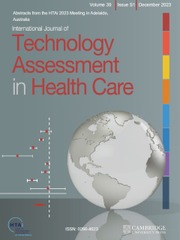Crossref Citations
This article has been cited by the following publications. This list is generated based on data provided by
Crossref.
2001.
CEU Part III: Evidence-Based Practice.
Perspectives on Neurophysiology and Neurogenic Speech and Language Disorders,
Vol. 11,
Issue. 1,
p.
10.
Pyle, Marsha A.
2002.
CONFERENCE PRESENTATION:Changing perceptions of oral health and its importance to general health: provider perceptions, public perceptions, policyma ker perceptions.
Special Care in Dentistry,
Vol. 22,
Issue. 1,
p.
8.
Schulman, Scott R.
Schardt, Connie
and
Erb, Thomas O.
2002.
Evidence-based medicine in anesthesiology.
Current Opinion in Anaesthesiology,
Vol. 15,
Issue. 6,
p.
661.
Jamileh, Y
and
Pedlar, J
2003.
Effect of clinical guidelines on practice for extraction of lower third molars: study of referrals in 1997 and 2000.
British Journal of Oral and Maxillofacial Surgery,
Vol. 41,
Issue. 6,
p.
371.
Sinuff, Tasnim
and
Cook, D.J
2003.
Guidelines in the intensive care unit.
Clinics in Chest Medicine,
Vol. 24,
Issue. 4,
p.
739.
Silva, Letícia Krauss
2003.
Avaliação tecnológica e análise custo-efetividade em saúde: a incorporação de tecnologias e a produção de diretrizes clínicas para o SUS.
Ciência & Saúde Coletiva,
Vol. 8,
Issue. 2,
p.
501.
Sampietro-Colom, Laura
Jackson, Shawna
Williams, Erin
and
Papatheofanis, Frank J.
2004.
Coronary Disease in Women.
p.
401.
WICKIZER, THOMAS M.
FRANKLIN, GARY M.
MOOTZ, ROBERT D.
FULTON‐KEHOE, DEBORAH
PLAEGER‐BROCKWAY, ROY
DRYLIE, DIANA
TURNER, JUDITH A.
and
SMITH‐WELLER, TERRI
2004.
A Communitywide Intervention to Improve Outcomes and Reduce Disability among Injured Workers in Washington State.
The Milbank Quarterly,
Vol. 82,
Issue. 3,
p.
547.
Liang, Bryan A.
and
Roy, Raymond C.
2004.
Can demonstrating board examination failure be proof of anesthesia negligence?.
Journal of Clinical Anesthesia,
Vol. 16,
Issue. 8,
p.
576.
Friedman, Zeev
Chung, Frances
and
Wong, David T.
2004.
Ambulatory surgery adult patient selection criteria — a survey of Canadian anesthesiologists.
Canadian Journal of Anesthesia/Journal canadien d'anesthésie,
Vol. 51,
Issue. 5,
p.
437.
Gilbert, Robert
and
Fader, Karren
2007.
Evidence-Based Decision Making as a Tool for Continuous Professional Development in the Medical Radiation Technologies.
Canadian Journal of Medical Radiation Technology,
Vol. 38,
Issue. 1,
p.
39.
McQueen, Karen
and
Dennis, Cindy-Lee
2007.
Development of a Postpartum Depression Best Practice Guideline.
Journal of Nursing Care Quality,
Vol. 22,
Issue. 3,
p.
199.
Lewison, G
and
Sullivan, R
2008.
The impact of cancer research: how publications influence UK cancer clinical guidelines.
British Journal of Cancer,
Vol. 98,
Issue. 12,
p.
1944.
Liang, Bryan A.
and
Fermani, Kara
2008.
“Standards” of anesthesia: law and ASA guidelines.
Journal of Clinical Anesthesia,
Vol. 20,
Issue. 5,
p.
393.
Apfelbaum, Jeffrey L.
Rupp, Stephen M.
Connis, Richard T.
and
Nickinovich, David G.
2013.
In Reply.
Anesthesiology,
Vol. 119,
Issue. 3,
p.
740.
Agbassi, Chika
Messersmith, Hans
McNair, Sheila
and
Brouwers, Melissa
2014.
Priority-based initiative for updating existing evidence-based clinical practice guidelines: the results of two iterations.
Journal of Clinical Epidemiology,
Vol. 67,
Issue. 12,
p.
1335.
Bush, Shirley H.
Bruera, Eduardo
Lawlor, Peter G.
Kanji, Salmaan
Davis, Daniel H.J.
Agar, Meera
Wright, David Kenneth
Hartwick, Michael
Currow, David C.
Gagnon, Bruno
Simon, Jessica
and
Pereira, José L.
2014.
Clinical Practice Guidelines for Delirium Management: Potential Application in Palliative Care.
Journal of Pain and Symptom Management,
Vol. 48,
Issue. 2,
p.
249.
2015.
Perineural Interventional Pain Management Techniques for Chronic Thoracic Pain Syndromes.
Journal of Anesthesia & Critical Care: Open Access,
Vol. 2,
Issue. 1,
Ferri, Marica
and
Griffiths, Paul
2015.
Textbook of Addiction Treatment: International Perspectives.
p.
1337.
Yam, Patricia
Lok, Laverne
Eastwood, John
Maher, Catherine
Ward, Meredith
Clews, Sara
Falconer, Janet
and
Oei, Ju Lee
2019.
Validation of hospital discharge coding for neonatal abstinence syndrome.
Acta Paediatrica,
Vol. 108,
Issue. 10,
p.
1786.

